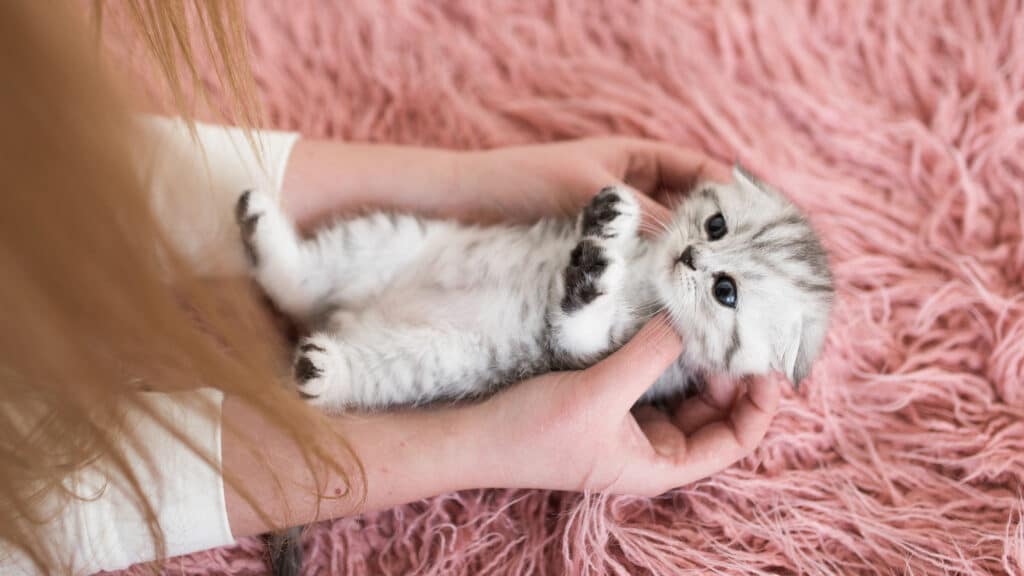Written by Jessica Mockett, Feline Behavior & Training Expert and Holistic Pet Health Coach

A kitten’s journey to becoming well-socialized with humans begins as early as two weeks old, with the critical socialization period waning at about nine weeks of age. During this time, kittens need to be held every day, handled gently, petted, groomed, introduced to new items and experiences, and generally adored. This time is also critical for becoming desensitized to sounds within the home, car rides and carriers, and the handling of sensitive-areas (like ears, mouth, eyes, paw pads). Kittens should remain with their mamas and siblings where at all possible until 12-13 weeks of age along with daily human interactions.
The feline family is an important staging ground for learning good habits, like using their mouth gently to avoid causing harm, especially during play interactions with humans and other animals. When we raise kittens, either for rescue adoptions or purchase, it is our responsibility to give them the best start possible. As someone who has raised around 100 kittens for rescue adoptions, with many of them being orphaned bottle-fed neonates, I always went the extra mile in socialization to make my kittens super desirable companion pets.
Recommendations for socialization are for 15-40 minutes of interaction with the kitten each day. When bottle feeding you interact with each baby kitten for many hours daily caring for their every need. I find that outside of meeting their feeding/pottying/grooming needs, spending a minimum of 60 minutes with each kitten every day, is what it takes to create very social cats.

Once the kitties in our charge are older, around four-and-a-half to five weeks of age, we really begin the training. Our care for them goes beyond picking up, snuggling, kissing, and cleaning up after them. Let’s go over what makes a kitten super-adoptable or a very desirable full-bred beauty.
Training Kittens:
Litter Boxes
- Usually, teaching a kitten to use a litter box is pretty simple. Most kittens with a mama cat do not need our assistance at all; she will show them how. But if we have an orphaned kitten or a slow learner, we help out.
- Provide boxes small enough for little 4–5-week-old kittens to climb in and out of easily. I use cardboard canned cat food boxes or metal disposable baking sheets. These typically have edges of only 1.5-2.5 inches high.
- Use a litter that is safe, avoiding clumping litters, chemically scented litters, or dyed litters as some kittens eat litter.
- When scooping, always keep a little bit of the pee and poop in the box to help the kittens to be drawn to the smells in the box.
- Have several litter box options scattered around the kitten nursery as little ones can get busy playing and forget until the last moment about going potty.
- Keep soft items like towels, blankets, and beds picked up, and limit them for a few weeks to avoid kitty selecting these places to use as a potty.
Solid Foods
- Weaning should not be forced on a kitten. Let them show interest and allow for them to get a little messy.
- Slowly introduce solid foods and be aware of how the kittens are handling the adjustments by looking out for diarrhea and offering preemptive or supportive care if this happens. I use supplements like Diagel, homeopathies, or just a tiny pinch of psyllium husk powder in wet foods.
- Ensure they are getting all the necessary calories for their fast growth rate. Kittens should gain weight every day.
- Over the course of their time with you eating solid foods, offer a wide variety of foods, different brands, textures, flavors. As they develop their palette, we want to make it as big as possible without causing digestive upset.
- Introduce the kitten to some amount of commercially created raw foods. Do so responsibly with holistic veterinary or professional pet nutrition support. This not only increases their wellness but will help them in the future if their new home wants to start or continue any amount of raw feeding.

Grooming & Touch Desensitizing
- Touch the kitten every day in places where in the future they may need grooming support or medical care. This helps to desensitize them to this type of handling. Include the ears, mouth, nose, eyes, and paw pads in this routine.
- Use a fear-free bundling technique, wrapping the kitten in a blanket or towel, squeezing in some water into the mouth by syringe, releasing from the wrap, and then offering rewards with praise, affection, or treats. This helps prep them for becoming more accepting of future meds.
- Start trimming claws as early as 2-3 weeks of age. Follow good guidelines and use appropriate trimming tools to avoid cutting the quick of the claws. Give praise, affection, and/or treat rewards after trims.
- Introduce a good brush for grooming and brush a few minutes every day.
- Introduce a toothbrush and gently brush teeth a few times a week.
Playing
- We need to be very careful to not encourage hand-play or foot-play with kittens. It can be tempting because they are so cute and tiny, but as they age and grow in their forever homes with this habit, it can set kitty up for aggression behavioral problems.
- Introduce a variety of safe toys.
- When kittens are young, at 4-5 weeks, go very slowly in your play to not intimidate or frighten them.
- Remember, all play for cats is about training for hunting or survival. Support these instincts by creating good hunting games and permit “wrestle mania” with siblings. If there is no siblings for wresting with, get a right-sized stuffed animal or kicker toy to use to manipulate in a wrestle mania game with the singleton.
- Play should build confidence in the kitten and strengthen their trust in humans.
Lap Time Snuggles
- To help create lap cats that new cat guardians so badly want, make sure to offer each kitten time to sleep in your lap daily or at least 3-4 times a week.
- Pull the kitten into your lap when they are sleepy and pet gently for a few minutes.
- Allow the kitten to sleep in your lap (or the crook of your arm, or on your shoulder) for at least 20 minutes undisturbed.
- When you have to get up or move the kitten, do so with gentleness and praise/affection.
- If the kitten seeks you out for snuggling, do not deny them access, because you want to create that habit that sleeping on a human is ideal.
Trusting
- We have to help each kitten feel that humans are trustworthy.
- Trust can be broken if we accidentally hurt them (i.e., stepping on them when they dive underfoot), so be sure to apologize and immediately love-up on the kitten and reassure them.
- Trust can weaken if we allow anyone in the household to intimidate them or roughhouse with them.
- Trust can reduce if we allow our children to handle kittens without correct instruction, boundaries, and gentleness. Interaction with children is ideal, but it has to be positive.
- Trust with humans can get strained if our homes have a lot of loud or chaotic noises. Exposure to noises is good, but overstimulation because of too much noise is not.

Exposure to the New
- Safely exposing kittens to new situations or places can be very valuable in helping them to become confident.
- If we keep our kittens in a single nursery until 12 weeks old and then they get picked up to go to a new environment, it can be very stressful to make that change. This is why exposure to new places, people, or pets between 5 weeks-12 weeks can help them adapt better for when they transition into a new home.
- Supervised outside time is great (in a play pen or romping in the grass, on a screened porch or a catio).
- Going to public places with kittens in the early weeks can help them be more adjusted to human-life, i.e., to cat shows, to the vet office, to the store (safely in a carrier in all those places).
- Introducing them to other animals like adult cats, dogs, birds, rodents, etc. can help them be more well-adjusted.
Harnesses, Car Rides, and Carriers
- Adopters and buyers get excited when a kitten is already harness trained, so help kitty become adjusted to wearing one. Simply start by leaving the harness out to be sniffed, then put it on and take it off immediately and give a treat. Each time you put it on, leave it on a bit longer, always giving praise, affection, and/or treat rewards when you remove the harness.
- Take the kittens on car rides, either with an end result in mind or just for a short drive and back home. The earlier you do this and the more consistently you do this, the less afraid the cat will be of cars their whole life.
- Make carriers a desirable location. Leave them out, use them as beds, places where treats or meals are served. Occasionally close the door when the kitten is inside, walk around the house, then return and open the door to release kitten. Offer praise and affection. Associate the carrier with good vibes.
When we can offer this kind of training to every kitten we care for, we set them up for a better life. Adopters and buyers are always more excited by well-socialized kittens, especially those with a fair amount of training that has already begun. It is such a joy to place them into homes that are eager about welcoming our kittens into their hearts.
If you would like to learn more on purrrfecting our care of cats, please find me here or pick up a copy of my book, Purrrfecting Your Bond.





















































































